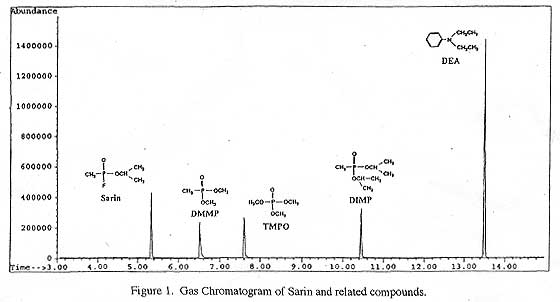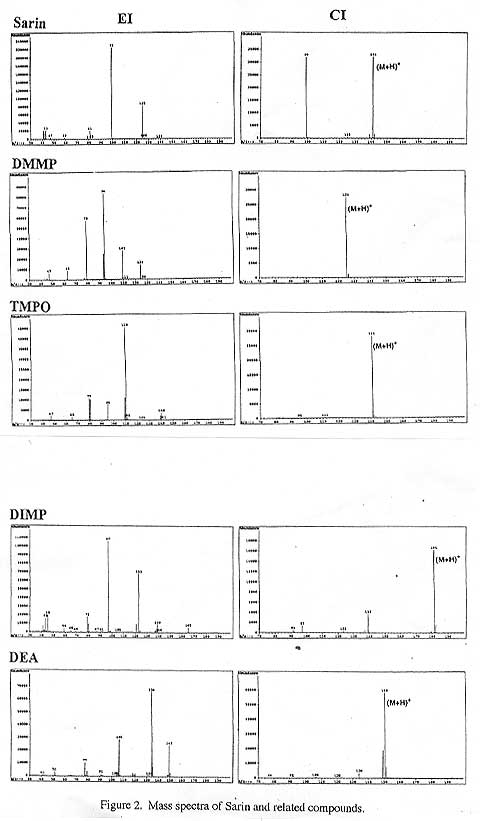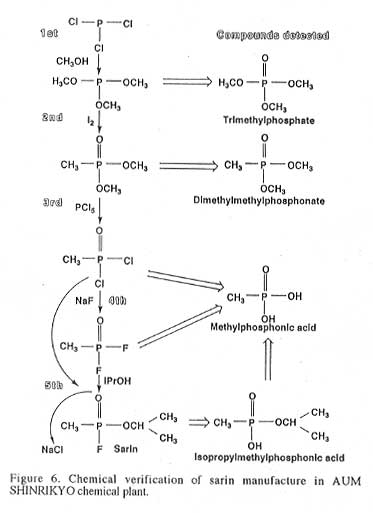「書籍・論文のサリン資料」の概要紹介&三浦評価
|
瀬戸康雄、角田紀子、片岡美江子、柘浩一郎、 T. Nagano(以上警察庁科学警察研究所)
|
|
|
重要度
3〜1の3段階で評価/ 数が多いほど重要 重要度は三浦の独断 |
2
|
|
○ 概要 抄録、前文、オウム真理教によって起こされたサリン事件のアウトライン(松本サリン事件、東京地下鉄サリン事件、サリン製造事件)、法科学調査で行なわれた科警研技術(コリンエステラーゼ分析評価、化学分析)、法科学調査の結果(松本サリン事件、東京地下鉄サリン事件、サリン製造事件)で構成されている。 ○ 以下、対訳で論文の内容を紹介 Outlines of Sarin Incidents caused by AUM SHINRIKYO. オウム真理教によって起こされたサリン事件のアウトライン。 Matsumoto Sarin Incident. The first sarin gas attack occurred in a quiet residential area of Matsumoto City, at midnight June 27, 1994. 松本サリン事件。最初のサリン毒ガス攻撃は、1994年6月27日深夜、松本市の静かな住宅地で起こった。 At 11:30 p.m. Matsumoto Police station received an urgent report from an ambulance team of the City Fire Defense Bureau that some patients were transported to a hospital. 午後11時30分、一部の患者が病院へ搬送された、との松本広域消防局救急隊からの緊急報告を、松本警察署が受け取った。 The cause of injury was not clear. 負傷の原因は、明らかでなかった。 The Nagano Prefecture Police Headquarters immediately started to rescue the injured and conduct investigations. 長野県警察本部は、ただちに負傷者を救助し、調査を指揮し始めた。 Five deceased residents were discovered at the site and two victims who had been injured and hospitalized subsequently died. 5人の亡くなった居住者は部屋で発見された。負傷し、入院した2人の犠牲者が、後で亡くなった。 About 270 people were treated in the hospital. およそ270人が、病院で治療を受けた。 Carcasses of dogs, sparrows, a dove and a large number of caterpillars were found in the area under some trees. 犬、スズメ、ハトや多数の毛虫の死骸が、何本かの木の下のところで見つかった。 In addition, discolored grass was observed in the garden, and dead fish and crayfish were found in a nearby pond. それに加えて、変色した草が庭で観察され、死んだ魚とザリガニが近くの池で見つかった。 Nearly all casualties were discovered in a sector-shaped residential area within a radius of 150 meters from the center near the pond. ほとんどすべての死傷者は、池の近くの中心から150メートルの範囲内で、扇形をした住宅地のエリアで発見された。 Persons near open window or in airconditioned rooms were severely affected. 開けた窓近くの人、またはエアコンが動いている部屋の人が、激しい被害を受けた。 Some victims observed a slow-moving fog with a pungent and irritable smell. 一部の犠牲者は、刺激のある、炎症性の臭いがする、ゆっくりただよう霧を観察した。 Typical symptoms of the victims were darkened vision, ocular pain, nausea, miosis and severely decreased serum cholinesterase (ChE) activities. 犠牲者の典型的徴候は、目の前が暗い、目の苦痛、吐き気、縮瞳であり、血清コリンエステラーゼ(ChE)活動がかなり減少していた。 Autopsy findings showed intense postmortem lividity, miosis, pulmonary edema, increased bronchial secretion and congestion of the parenchymatous organs. 検死調査結果は、死んで濃い鉛色になり、縮瞳、肺浮腫、気管支分泌の増加、柔組織器官のうっ血を示した。 Tokyo Subway Sarin Incident. Sarin mass terrorism occurred inside trains on three Eidan-subway lines during the morning rush-hour peak on March 20, 1995. 東京地下鉄サリン事件。1995年3月20日朝、ラッシュアワーのピークに、三本の営団地下鉄線の電車で、サリン大量テロリズムが起きた。 Passengers and station personnel were overcome by fumes in the train cars, as well as within Kasumigaseki and Tsukiji stations. 霞ヶ関と築地駅の中のみならず、電車のなかで、乗客と駅員は煙霧にまかれた。 The Tokyo Metropolitan Police Department immediately began to rescue the injured, to conduct traffic control and to investigate the incident. 警視庁は、直ちに負傷者を救助し、交通管制を行い、事件を調査し始めた。 Evidence samples, such as containers, newspapers and other remains were collected, and the Forensic Science Laboratory identified sarin by gas chromatography-mass spectrometry (GC/MS) in a short time. 証拠サンプル、例えば容器、新聞やその他のものが集められた。科学捜査研究所は短時間のうちに、ガスクロマトグラフィー-質量分析(GC/MS)によって、サリンを確認した。 This conclusion was possible because of our previous experience in the Matsumoto Incident. 松本事件における我々の前の経験によって、この結論は可能だった。 The cult decided to use sarin in trains on the three subway lines, all of which stop at Kasumigaseki station near the Metropolitan Police Department. カルトは3本の地下鉄路線でサリンを使うことに決めた。その3本の線のすべては、警視庁の近くの霞ヶ関駅で止まることになっていた。 Twelve passengers and station personnel were killed, and approximately 5000 people were injured. 12人の乗客と駅員が死に、およそ5000人が負傷した。 Typical symptoms were darkened vision, ocular pain, nausea, miosis, hyperemia and nosebleed. 典型的症状は、暗く見える、目の苦痛、吐き気、縮瞳、充血と鼻血だった。 Autopsy findings were nearly identical to those in the Matsumoto Sarin Incident. 検死調査結果は、松本サリン事件のときとほとんど同じだった。 The sarin manufacture case. Sarin was manufactured in the Cult facilities in Kamikuishiki, Yamanashi Prefecture near Mt. Fuji. サリン製造事件。サリンは、富士山近くの山梨県・上九一色村のカルト施設で製造された。 On 1994 July, inhabitants in the vicinity of a cult facility noticed some foul smells. 1994年7月、カルト施設の近くの住民は、臭いにおいに気がついた。 Later, a sarin hydrolysis product was detected from a soil sample taken near the site. 後で、サリンの加水分解物質が、敷地近くで採取された土のサンプルから検出された。 Furthermore, police seized evidence which showed that cult dummy companies had purchased a large quantity of the raw materials for manufacturing sarin. さらに警察は、カルトのダミー会社がサリンを製造するのに必要な原料を大量に購入したことを示す証拠をつかんだ。 On March 22, 1995, a simultaneous raid of the cult facilities was launched by 2500 police personnel in connection with the confinement of the notary public manager to death. 1995年3月22日、公証人の監禁致死と関連して、カルト施設への一斉強制捜査が、2500人の警察官によって開始された。 The search uncovered a large amount of chemicals such as phosphorus trichloride, as well as a chemical plant in No. 7 Satyam building. 捜索によって、第七サティアンの化学プラントだけでなく、三塩化リンのような化学薬品が大量に明らかになった。 Nearly all the cult perpetrators were arrested within two months. ほとんどすべてのカルト犯人は、2ヵ月以内で逮捕された。 In the chemical plant building, various types of equipment required for the manufacture of chemicals were found. 化学プラントの建物では、化学薬品の製造のために必要ないろいろな種類の器材が見つかった。 Through the investigation of the plant facilities, the police concluded that a very strong suspicion existed for the construction and operation of the plant used to produce sarin. プラント施設の調査を通して、警察は、サリンを製造するのに使われるプラントで、生産設備だという疑いが非常に強く存在する、と結論づけた。 Laboratory techniques performed in forensic investigation. 法科学調査で行なわれた科警研技術。 The special nature of nerve gases restricted police efforts for an early solution. 神経ガスの特別な性質によって、警察は、早期解決をすることができなかった。 First, nerve gases are objects of The Law on the Ban of Chemical Weapons and the Regulations of Specific Substances, which was enacted in May 1995 in Japan, but only after the attacks occurred. 最初に、神経ガスは、化学兵器の禁止及び特定物質の規制に関する法律の対象である。この法律は、日本では1995年5月に制定されたが、すでに事件が起きたあとだった。 Second, nerve gases are highly toxic, and lethal in trace amounts. 二番目に、神経ガスは非常に有毒で、ほんのわずかな量で致命的となる。 Third, they are volatile. 第三に、それらは化学的に不安定である。 Handling of samples requires caution, and it is difficult to detect nerve gases because of rapid evaporation. サンプルの取り扱いは注意を必要とする。神経ガスは急速い揮発するため、検出するのが難しい。 Fourth, nerve gases are chemically labile and easily hydrolyzed to alkylmethyiphosphonate. 第四に、神経ガスは化学的に変化しやすくて、簡単にアルキルメチルホスホネートに加水分解する。 In order to verify nerve gas exposure, it is necessary to identify the degradation products, rather than the nerve gas instead. 神経ガスの被爆を確かめるために、神経ガスそのものよりむしろ、分解生成物を確認することが必要である。 However, sarin is toxic at very low levels and covalently binds to hydrolytic enzymes, therefore it is difficult to detect isopropylmethyiphosphonate (IMPA) in the blood of a victim. しかし、サリンは非常に低いレベルでも有毒で、加水分解酵素と共有結合し、容易に加水分解してしまうので、犠牲者の血の中からメチルホスホン酸イソプロピル(IMPA)を検出するのが困難である。 The detection of free IMPA or sarin, liberated from a ChE adduct, may be useful for the verification of sarin poisoning. コリンエステラーゼ付加物から遊離した、フリーのIMPAやサリンを発見することは、サリン中毒の確認に役立つ。 However, a decrease in blood ChE activity remains the index of sarin exposure. しかし、血液のコリンエステラーゼ活動の減少は、サリン被爆の指標としてそのまま有効である。 We performed toxicological analysis of crime scene evidence samples. 我々は、犯行現場の証拠サンプルの毒物分析をした。 First, we carried out ChE assays on victim's blood samples. 最初に、我々は犠牲者の血液サンプルのコリンエステラーゼ分析を行なった。 We then carried out chemical analysis of victim's blood, water, soil and wipe samples, by organic solvent extraction and GC/MS. 我々はそれから、有機溶媒抽出とGC/MSによって、犠牲者の血液、水、土、拭いたサンプルを化学分析した。 The analytical system used in our forensic investigation makes it possible to detect trace levels of toxic substances, and also provides chemical proof for usage, possession and production of chemical warfare agents. 我々の法科学調査において使用される分析システムは、有毒な物質の微量レベルを検出し、そのうえ化学兵器剤の使用、所有の化学的立証することを可能にしている。 Chemical analysis. In water, nerve gases are easily hydrolyzed, producing characteristic methyl phosphorus bonding compounds which are metabolically stable, water soluble and never found in nature. 化学分析。水の中で、神経ガスは簡単に加水分解される。そして、代謝的に安定していて、自然において決して見つからない水溶性の、特徴のあるメチルリン結合の化合物を合成する。 These alkylmethylphosphonates are unique for the original nerve gases. これらのアルキルメチルホスホネートは、本来の神経ガスはそれぞれユニークである。 [三浦注:ユニークとは、加水分解すると、サリンがメチルホスホン酸イソプロピルIMPAに、ソマンがメチルホスホン酸ピナコリルPMPAに、VXがメチルホスホン酸エチルEMPAにそれぞれ成ることをさしている] They are ultimately hydrolyzed to methyiphosphonic acid (MPA). これらは、最終的にメチルホスホン酸(MPA)に、加水分解される。 Therefore, detecting the hydrolysis products can provide indirect proof for the existence of nerve gas. したがって、加水分解物質を検出して、神経ガスの存在を、間接的に証明することができる。 Samples wiped with cotton were extracted with dichloromethane and then with water. 綿でふかれたサンプルは、ジクロロメタンで、さらに水で抽出された。 【三浦注】:綿で拭かれたサンプル、とはどこを拭いたのだろうか。後で出てくるオウムの施設の第一工程から採取されたサンプルと同じものなのか。この段階で、はっきりさせてほしいものである。 After the water fraction is adjusted to a neutral pH, both the dichloromethane and water fractions are combined, and again shaken. 水部分を中性pHに調整したあと、ジクロロメタンと水部分は混ぜられ、再び振られる。 Soil samples were extracted with water and then with dichloromethane. 土サンプルは、水で、さらにジクロロメタンで抽出された。 【三浦注】:サンプルは、どこで採取されたものだろうか。もしかしたら、前に出てきた、オウムの敷地近くから得られた土のことなのだろうか。はっきり書いてほしいものである。 Blood samples were deproteinized with perchloric acid, and the resulting supernatant were adjusted to a neutral pH, and extracted with dichloromethane. 血液サンプルは過塩素酸でたんぱく質を取り除かれ、結果として生じる上澄みは中性pHに調整され、ジクロロメタンで抽出された。 【三浦注】:血液サンプルは、どの事件の犠牲者から採ったものなのか。松本サリン事件、それとも地下鉄サリン事件なのか、それとも両方か。 Nerve gases and their intermediates and byproducts are extracted into the organic solvent fraction, and after concentration under mild conditions, subjected to GC/MS. 神経ガスやそれらの中間体と副生成物は、有機溶媒断片に抽出されて、穏やかな状況の下で濃縮の後、GC/MSにかけられる。 The hydrolysis products of nerve gases are extracted into the aqueous fraction, and after derivatization, subjected to GC/MS. 神経ガスの加水分解物質は水溶液の中に抽出され、誘導化の後、GC/MSにかけられる。 Compounds in the organic solvent fraction can be simultaneously separated using apolar DB-5 capillary column and by multi-step temperature program starting from an oven temperature of 45 ℃. 有機溶媒解断片の中の合成物は、無極性 DB-5のキャピラリー・カラムを使い、45℃の乾燥器の温度から始まる複数ステップの温度プログラムによって、いっせいに分離することができる。 【三浦注】:DB-5とは、ガスクロマトグラフで使う、15m×0.32mmφ×0.25μmのカラム。保持時間は、サリンで2.9分。 Two types of GC detections are typically used. ニ種類のガスクロマトグラフィー検知器が概して使われる。 MS with electron impact ionization (EI) and isobutane chemical ionization (CI) provides both chemical and structural information. 電子衝撃イオン化(EI)とイソブタン化学イオン化(CI)を備えるマススペクトルは、化学・構造上の情報を与えてくれる。 Atomic emission detection is highly selective for monitoring phosphorus-containing compounds. 原子発光検出器は、リンを含有する合成物をモニターするために非常に選択力がある。 Molecules in the cavity are degraded to their elements and the atomic emission can be detected under selected wavelength. 空洞共振器のなかで分子は要素に分解され、原子発光を特有の波長の下で見つけることができる。 【三浦注】:空洞共振器とは、導体壁でとり囲まれた電磁波の共振空間のこと Figure 1 shows total ion chromatogram of 300-900 ppm of sarin, dimethylmethylphosphonate (DMMP), trimethylphosphate (TMPO) and diisopropylmethylphosphonate (DIMP). 図1は、サリン、メチルホスホン酸ジメチル(DMMP)、トリメチルホスフェイト(TMPO)、メチホスホン酸ジイソプロピル(DIMP)の300-900 ppmのトータル・イオン・クロマトグラムを示している。 
Figure 1,Gas Chromatogram of Sarin and related compounds. 図1、サリンと関連化合物のガスクロマトグラム。 【三浦注】:どこの試料を分析したデータであろうか。はっきり明示してほしいものである。 The later three are typical precursors or byproducts of sarin synthesis. あとの三つは、サリン合成の典型的な前駆物質または副生成物である。 EI-mass spectra offered representative fragmentation patterns and CL-mass spectra gave quasi-molecular ions as base peaks (Figure 2). EIマススペクトルは、典型的なフラグメンテーション・パターンを表し、CIマススペクトルは、基準ピークに擬分子イオンを示している(図2)。 
Figure 2,Mass spectra of Sarin and related compounds. 図2、サリンと関連化合物のマススペクトル。 【三浦注】:これもどこからとったデータなのかはっきりしない。 Hydrolysis products of nerve gases in the aqueous fraction are obtained by evaporation of the water, and N-methyl-tert.-butyldimethylsilyltrifluoroacetamide and acetonitrile are added, heated and injected into the GC/MS (13). 水溶性の神経ガスの加水分解物質は水の蒸発によって得られる、そして、N-メチル・ター・ブチルジメチルシリルトリフルオロアセタミドとアセトニトリルが加えられ、熱されて、GC/MSにかけられる。 Figure 3 shows a total ion chromatogram of tert.-butyldimethylsilylated hydrolysis products (30-45 ppm) of nerve gases, ethylmethylphosphonate (EMPA) from VX agent, IMPA from sarin, pinacolylmethylphosphonate (PMPA) from soman, and MPA. 図3は、神経ガス、VX剤からのエチルメチルホスホネート(EMPA)、サリンからのIMPA、ソマンからのピナコリルメチルホスホネート(PMPA)、そしてMPAのター・ブチルジメチルシリル化された加水分解物質製品(30-45 ppm)のトータル・イオン・クロマトグラムを示している。 The mass spectra offered representative fragmentation pattern on El-MS and quasimolecular ions on CL-MS (Figure 4). マススペクトルは、EI-MSの典型的なフラグメンテーション・パターン、CI-MSで擬分子イオンを示している(図4)。 Results of forensic Investigation. 法科学調査の結果。 Matsumoto Sarin incident. Sarin was detected in one sample of the pond water, and also in the nasal mucosa of one victim. 松本サリン事件。サリンは、池水から採ったサンプル、さらに、1人の犠牲者の鼻粘膜にも認められた。 This represents the first case where sarin is detected in a sample from a victim. このことは、サリンが犠牲者のサンプルから検出された最初のケースを示している。 We have no authentic "sarin" as a standard. 我々は、標準とする本物の「サリン」を持っていない。 However, observed retention index (817) is very similar to values quoted in the literature. しかし、観察された保持インデックス(817)は、文献で見積もられる数値と、非常に類似している。 The El-mass spectrum was also identical to previously published data. EIマススペクトルは、また、以前発表されたデータと同一だった。 The CI-mass spectrum gave quasimolecular ions of m/z 141. CIマススペクトルは、 141m/zの擬分子イオンを与えた。 Furthermore, one peak was observed under atomic emission detection with a phosphorus emission line near the position of the retention index of 817. さらに、1つのピークは、817のリテンション・インデックス位置近くで、リン輝線をもつ原子発光が観察された。 IMPA and MPA were detected in numerous samples from victim's blood, as well as wipe samples. IMPAとMPAが、拭いたサンプルだけでなく、多数の犠牲者の血液サンプルから見つかった。 In addition, from the discolored blades of grass, a high level of fluoride and chloride was identified by capillary electrophoresis. それに加えて、変色した草の葉から、フッ化物と塩化物の高いレベルが、キャピラリー電気泳動によって確認された。 【三浦注】:キャピラリー電気泳動は、キャピラリー・カラム(内径0.5mm以下の細い管)に電解質溶液を満たし、試料を入れ、電圧をかけると、イオン化された試料の成分が移動し、ピークで検出することができることを利用する方法。 Allegedly, the perpetrators sprayed the lethal gas from evaporator-type spray containers. 伝えられるところでは、犯人は蒸発器-タイプ・スプレー容器から、致死性ガスをスプレーした。 They fabricated the spraying device by modifying a refrigerator-car, which contained a heating-pot and fan. 暖房ポットとファンを備えた冷蔵車を改造することによってスプレー装置を製作した。 In the Cult chemical plant, sarin was produced by adding isopropyl alcohol to a mixture of methylphosphonyl difluoride and methylphosphonyl dichloride. カルトの化学プラントでは、サリンはイソプロピルアルコールをメチルホスホン酸ジフルオリドとメチルホスホン酸ジクロリドの化合物に加えることによって合成された。 Because the reaction conditions were in error, the yield of sarin was low, and by-products were produced. 反応過程でエラーがあったので、サリンの収量は低く、副生成物が合成された。 After storage for nearly 3 months, this solution was released by evaporation with forced heating over a 10 minute period. ほぼ3ヵ月の間の保管の後、この溶液は、10分間にわたって強制的加熱による蒸発によって放出された。 High levels of sarin hydrolysis products were detected from even injured victims, and high levels of DIMP were also detected. サリンの加水分解物質が高いレベルで、負傷した犠牲者からさえ見つけられた、そして、メチルホスホン酸ジイソプロピルDIMPも高いレベルで検出された。 This suggests that the sarin solution was composed of not only sarin itself but also the other sarin synthesis precursors and byproducts. これは、サリン溶液が、サリンだけでなく他のサリン合成前駆物質や副生成物から構成されていることを示唆している。 Tokyo Subway Sarin Incident. Sarin-containing vinyl bags were used for mass terrorism. 東京地下鉄サリン事件。サリンを含むビニル・バッグが、大規模なテロリズムのために使われた。 The perpetrators boarded subway trains with these plastic bags, and released the gas by puncturing them with the metal tips of umbrellas. 犯人は、これらのプラスチック袋を持って地下鉄電車に乗り込んで、傘の金属先端部分で刺すことによってガスを放出した。 Sarin, n-hexane and N,N-diethylaniline (DEA) were identified as major components from a sarin bag which was obtained at the scene. 現場で得られたサリン入り袋から、サリン、ヘキサン、ジエチルアニリン(DEA)が、主な構成成分として同定された。 IMPA was detected in blood samples from only two victims. メチルホスホン酸イソプロピルIMPAが、2人の犠牲者から採った血液サンプルで見つかった。 Allegedly, in the Cult chemical laboratory, sarin was produced by adding isopropyl alcohol to 1.4 kg of methylphosphonyl difluoride, using n-hexane as solvent and DEA as the acid neutralyzer. 伝えられるところでは、カルトの化学研究所では、サリンは1.4キログラムのメチルホスホン酸ジフルオリドにイソプロピルアルコールを加えて、合成された。溶媒としてヘキサンと酸中和剤としてジエチルアニリンDEAを使用した。 The resultant solution, about 7 liters, was divided into 11 bags. 合成された溶液は、およそ7リットルで、11の袋に分割された。 From forensic investigation, the concentration of sarin was determined to be about 30%, and this value is supported by the testimony of suspects. 法科学調査から、サリンの濃度はおよそ30%であると決定された、そして、この値は容疑者の証言によって支えられている。 Sarin manufacture case. From the police investigation of the chemical plant, synthetic route of sarin mass manufacture was disclosed. サリン製造事件。化学プラントの警察調査から、サリン大量製造の合成のルートが明らかにされた。 The protocol was comprised of 5 stages. 実験計画は、5つの工程から成っていた。 In the 1st stage, phosphorus trichloride was reacted with methanol to produce trimethylphosphite. 第1工程では、三塩化リンがメタノールと反応を起こし、亜リン酸トリメチル(トリメチルホスファイト)を合成する。 In the 2nd stage, trimethylphosphite was converted to DMMP via a thermal rearrangement reaction. 第2工程では、亜リン酸トリメチル(トリメチルホスファイト)が熱転位反応を通してメチルホスホン酸ジメチルDMMPに変換された。 In the 3rd stage, DMMP was reacted with phosphorus pentachloride with heating, to produce methyiphosphonyl dichioride. 第3工程では、DMMPを五塩化リンと加熱反応させ、メチルホスホン酸ジクロリドを合成する。 In the 4th stage, methyiphosphonyl dichioride was reacted with sodium fluoride to produce methyiphosphonyl difluoride. 第4工程では、メチルホスホン酸ジクロリドとフッ化ナトリウムで反応させ、メチルホスホン酸ジフルオリドを合成した。 In the final stage, methyiphosphonyl difluoride and methyiphosphonyl dichioride were mixed with isopropyl alcohol to produce sarin. 最終工程では、メチルホスホン酸ジフルオリドとメチルホスホン酸ジクロリドに、イソプロピルアルコールを混ぜ合わせ、サリンを合成した。 From the wiped samples taken from the 1st stage equipment, TMPO, n-hexane and DEA were detected. 第1工程装置から採った拭かれたサンプルから、トリメチルホスフェイトTMPO、ヘキサン、ジエチルアニリンDEAが見つかった。 【三浦注】:拭かれたサンプルとは、オウムの施設から採取されたものだったのか。 From the 2nd stage equipment, TMPO, DMMP, iodine and DEA were detected. 第2工程装置から、トリメチルホスフェイト、メチルホスホン酸ジメチルDMMP、ヨウ素とジエチルアニリンが、見つけられた。 From the 3rd stage equipment, MPA, DEA, phosphorus oxychloride and sodium chloride were detected. 第3工程装置から、メチルホスホン酸MPA、ジエチルアニリン、オキシ塩化リン(塩化ホスホリル)と塩化ナトリウムが検出された。 From the 4th stage equipment, MPA, DEA, sodium chloride and sodium fluoride were detected. 第4工程装置から、メチルホスホン酸、ジエチルアニリン、塩化ナトリウムとフッ化ナトリウムが検出された。 From the final stage equipment, IMPA, MPA, DEA, DMMP and sodium chloride were detected. 最終工程装置から、メチルホスホン酸イソプロピルIMPA、メチルホスホン酸、ジエチルアニリン、メチルホスホン酸ジメチルと塩化ナトリウムが検出された。 As shown in Figure 6, from the chemical analysis of evidence samples taken from the scene of manufacturing plant, stable substances derived from the precursors and the products and byproducts corresponding to synthetic routes, have been identified, which provides both evidence and verification of sarin synthesis by the Cult. 図6で示すように、製造工場の現場からとられた証拠サンプルの化学分析から、安定した物質は前駆物質と生成物と副生成物から合成された。同定されたこれらの物質は、合成のルートと一致しており、カルトによるサリン合成の証拠と立証を提供している。 
Figure 6, Chemical verification of sarin manufacture in AUM SHINRIKYO chemical plant. 図6、オウム真理教の化学プラントでサリンが製造された化学的証拠。 |
|
|
科警研が発表したもののなかでは、もっとも具体性がある論文である。 ただ問題なのは、載せた図面や記事にデータの出所をはっきり書いていないことである。 これって、論文としての資格に欠けるのではないか、と思われるがどうであろうか。 図1は「サリンと関連化合物のガス・クロマトグラム」となっているが、どういう試料を分析して、このような図になったのか、はっきりしない。 たぶん、オウムの施設から出たものではないかと、推測するだけである。 図2も、「サリンと関連化合物のマス・スペクトル」とあるだけで、同じようにはっきりしない。 図6は、「オウム真理教化学プラントでのサリン合成の化学的証拠」とあるので、はっきりわかる。このように書いてほしいものである。 犠牲者の血液が、どの事件のものなのか、はっきりしないし、 土のサンプルもどこからとったのかわからない。 土は、オウムの敷地からサリンの加水分解物を検出したことが書いてあるので、もしかしたら、オウムの敷地にあった土のことを指しているのだろうか。 拭いたサンプルがオウムの施設で採取したらしいとわかる。 この論文自体が、オウム説施設でのサリン製造を重点に書いているようなので、たぶんそうだろう、と判断するだけである。 せっかくのデータなので、きちんと書いてほしいものである。 本文から判断すると、図1は、犠牲者の血液、池の水、オウム施設の土、オウム施設を拭いた綿を分析したデータ思われる。(一つのものから検出されたものを記載するのではなく、まとめて記載するのは、なぜだろうと疑問がわくのだが)科警研が検出したのは、サリン、メチルホスホン酸ジメチルDMMP、トリメチルホスフェイトTMPO、メチルホスホン酸ジイソプロピルDIMP、ジエチルアニリンDEAだった。 さらにこの論文では、オウムの施設から得た検出物から、どのような工程でサリンを合成したのかを推測し、くわしく説明している。 検出されたのは、 トリメチルホスフェイトTMPO、ヘキサン、ジエチルアニリン、メチルホスホン酸ジメチルDMMP、ヨウ素、メチルホスホン酸MPA、オキシ塩化リン(塩化ホスホリル)、塩化ナトリウム、フッ化ナトリウム、メチルホスホン酸イソプロピルIMPA だった。 このうちTMPOトリメチルホスフェイトP(O)(OCH3)3だけが聞いたことがなかったが、 Tu『化学・生物兵器概論』(じほう)59頁によれば、 この物質は、第一工程でできた亜リン酸トリメチル(トリメチルホスファイト)が変化したもの、だという。 注目すべき重要な点をあげてみる。 松本事件で、原因がサリンとわかった理由を述べている。 池の水から採取したサンプルから見つかった。それと、ある犠牲者の鼻の粘膜からも検出された。 1、 検出された物質のリテンション・インデックスが、サリンの文献による数値817(DB-5のとき)とほぼ一致していた。 2、 EIマススペクトルが、すでに発表されていたデータと一致していた。 3、 CIマススペクトルが、擬分子イオン141m/zを示した。 4、リテンション・インデックス817近くに、リン輝線を示すピークがあった。 5、サリンの加水分解物IMPAとMPAが、拭いたサンプルと多数の犠牲者の血液から検出された。 6、変色した草の葉から、フッ化物と塩化物が高いレベルで、検出された。 松本事件で、科警研のくわしい論文はまだ見ていないが、どこかに発表しているのだろうか。 確認したいものである。 東京地下鉄事件では、 1、 現場から得られた袋からサリン、ヘキサン、ジエチルアニリンを検出した。 2、 ふたりの犠牲者の血液から、サリンの加水分解物IMPAが検出された。 現場の袋から、サリン、ヘキサン、ジエチルアニリンなどが検出されたことは、ほかの検出物 MPFメチルホスホネート・フルオリドCH3P(O)FOH、 DIMPメチルホスホン酸ジイソプロピルCH3P(O)[OCH(CH3)2]2、 DFPジイソプロピルフルオロホスホネートP(O)F[OCH(CH3)2]2、 と合わせて、警視庁科捜研がくわしく書いている。 |
|
戻る